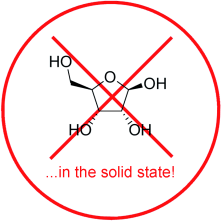Secret revealed: The crystal structure of ribose

(PhysOrg.com) -- D-Ribose is just a small molecule - but an extremely important one for us life forms. It is astounding that the crystal structure of ribose is not included among the over 500,000 structures that have been solved. After all, ribose is a fundamental building block of ribosomes, the “protein factories” of cells. A Nobel Prize was awarded in 2009 for studies of the structure and function of ribosomes.
In the journal Angewandte Chemie, the winners of this prize have just presented a first-hand report of their research. Also in Angewandte Chemie, a team of German and Swiss-based researchers has now presented another long-sought result: they have finally been able to solve the crystal structure of ribose.
Ribose belongs in the chemical class of sugars. Its backbone is a chain of five carbon atoms; four of them carry an OH group, the fifth an oxygen atom attached by a double bond. In most modern textbooks and handbooks, ribose is represented as a β-furanose: four of the carbon atoms and the oxygen atom form a five-membered ring. However, it has been known for over 40 years that in solution, ribose exists as a mixure of four different structures: α- and β-furanoses as well as α- and the dominant β-pyranose. Pyranoses are a form of sugar in which the five carbon atoms and an oxygen atom form a six-membered ring. The prefix α or β indicates whether a specific OH group lies above or below the plane of the ring.
But what form does crystalline ribose adopt? Whereas the structures of other important sugars have been known for a long time, ribose has been reluctant to reveal its secret; the compound is extremely difficult to crystallize. Despite such adverse conditions and countless failed attempts, the team led by Lynne B. McCusker, Beat H Meier, Roland Boese, and Jack D. Dunitz at the ETH Zurich (Switzerland) and the University of Duisburg-Essen have finally succeeded in cracking the structure. By using complex computer calculations, they were first able to obtain meaningful results from X-ray diffraction analyses of powder samples.
They were then also able to produce single crystals by zone-melting recrystallization. In this technique, only a small zone of the material is heated and this melt zone is moved. The cooling melt then solidifies with a uniform crystal structure to form the desired single crystal. This can then be examined in by X-ray crystal-structure analysis. Solid-state NMR spectroscopic studies yielded further, complementary information about ribose.
Overall, the researchers came to the realization that D-ribose molecules crystallize as pyranoses, which are six-membered rings. These are present in two crystalline forms that contain β- and α-pyranose in various proportions.
More information: Jack D. Dunitz, The Crystal Structure of D-Ribose—At Last! Angewandte Chemie International Edition 2000, 39, No. 26, 4503-4505, dx.doi.org/10.1002/anie.201001266
Provided by Wiley


















